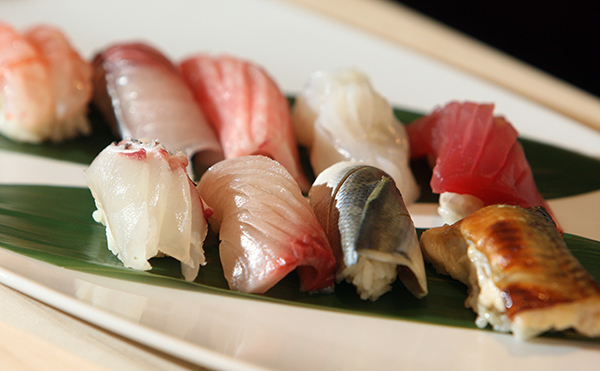Globalization of fish lowers prices, stocks

The Korean market used to be dominated by shrimp from Southeast Asia, mostly Thailand and Vietnam, but a few years ago, Saudi Arabian shrimp was introduced. Black tiger shrimp from India and banana-colored Australian shrimp are also popular, and latest newcomer is shrimp from Ecuador, Peru and Cuba.
Mackerel is the favorite for many Koreans, and Norwegian and Canadian fish are rapidly replacing indigenous catches. In late autumn, the half-dried saury is a seasonal delicacy mostly from Taiwan. Shoppers can also find American monkfish and sea eels, Mexican croakers, Russian mackerel, Argentinian skates and Vietnamese webfoot octopus. The halibut sold in bulk in the frozen section is from Guinea.
In fact, the hairtail I had at the cafeteria for lunch looked a bit strange, rather black and thick-boned. The cafeteria manager explained that the fish came from Senegal. African fish are commonly used in cafeterias and institutional food services. Croakers, which boost stamina, are mostly from war-torn Sierra Leone. The squid are from the Falkland Islands off South America or New Zealand, and what we think are octopus legs sold at baseball games are likely to be giant squid from Central and South America. Some restaurants specializing in soy marinated crabs use American blue crab.
The globalization of seafood reminds me of my business trip to Cuba in 2005. I was covering the opening of the Kotra trade center in Havana and heard about a Korean businessman working in the fisheries industry. When Mr. Choi, who lived in Venezuela, visited Cuba in 1990, he learned a curious fact. Sea cucumbers are common in Cuba, which is surrounded by shallow water, but Cuban people do not eat sea cucumbers. So he obtained the exclusive right to gather the sea cucumbers and made a fortune selling them in China and Hong Kong.
Cuban sea cucumbers consumed in Hong Kong is a Ricardian model solution of turning the discrepancy of supply and demand into a trade opportunity. It can be a strategy to fight soaring seafood prices, a phenomenon known as “finflation.”
However, a bitter feeling remains. Depletion of fisheries is a worldwide problem, so how long can we continue to satisfy our appetite with African hairtails? The octopus catch in the poverty-ridden African country of Mauritania decreased by half after Chinese and Japanese boats obtained fishing rights. However, the certificate of origin may be nothing but a label for the gluttony of the people.
The author is a national news writer.
by Yoon Chang-hee
집 앞 대형마트에서 초밥을 담으며 세계화를 실감했다. 모리타니 문어, 세네갈 피뿔고동, 아이슬란드 열빙어알, 노르웨이 연어, 캐나다 북방조개, 칠레 송어, 대만 농어… 초밥 10여개에 5대양 6대주가 담긴다. 수산물 매장으로 가니 더 다채롭다. 새우 코너는 글로벌 격전장이다. 태국·베트남 등 동남아산(産)이 장악하던 국내 시장에 몇 년 전 사우디아라비아 새우가 등장했다. 사막 모래바람만 날리는 줄 알았던 사우디에 모세가 건넌 홍해 바다가 있다는 사실을 새삼 깨달았다. 인도산 블랙타이거와 바나나 빛깔의 호주 새우도 한 자리 차지하더니, 최근엔 남미산 새우가 다크호스다. 에콰도르와 페루에 이어 쿠바 새우도 들어온다는 소식이다. ‘국민 생선’ 고등어는 노르웨이와 캐나다산이 국내산을 빠르게 대체 중이다. 늦가을 찬 바람이 불면서 막 나오기 시작된 과메기의 원재료는 대만산 꽁치다. 미국산 아귀와 꼼장어, 멕시코산 참조기, 러시아산 이면수, 아르헨티나산 홍어, 베트남산 주꾸미도 보인다. 냉동 코너에서 파는 묶음 가자미는 원산지가 기니아산으로 돼 있다. 그러고 보니 오늘 점심때 구내식당에서 먹은 갈치도 외관이 생소하다. 약간 검은 빛깔이 나고, 가시는 억세다. 영양사에게 물어보니 아프리카 세네갈 산이란다. 원산지에 덜 민감한 단체 급식에서 아프리카 생선은 이미 대세다. 보양식으로 많이 먹는 민어의 경우 오랜 내전을 겪어온 시에라리온에서 많이 수입된다. 구내 식당 밑반찬으로 나오는 오징어 무침은 남미 포클랜드산이거나 뉴질랜드산, 야구장 앞에서 사먹는 문어다리는 중남미에서 잡히는 대왕오징어일 가능성이 크다. 심지어 간장게장 집에서 미국산 블루크랩을 쓰는 경우도 적지 않다고 한다. 수산물 세계화를 얘기하다 보니 2005년 쿠바 출장이 기억난다. KOTRA 아바나 무역관 개장을 취재하러 갔다가 한국인 수산업자 얘기를 들은 적이 있다. 베네수엘라에 살던 최모씨는 1990년 중반 쿠바에 갔다가 귀가 번쩍 뜨이는 얘기를 들었다. 쿠바는 수심이 얕은 바다가 넓게 펴져 있는 ‘해삼 밭’이지만, 쿠바 사람들은 해삼을 먹지 않고 버렸다. 이를 본 최씨가 독점 채취권을 따내 중국과 홍콩에 팔면서 큰 돈을 벌고 있다는 것이다. 쿠바의 해삼이 홍콩의 식단에 오르는 수산물 세계화는 수요와 공급의 불일치를 교역으로 푸는 리카아도식 해결법인 셈이다. 수산물 가격이 폭등하는 피시플레이션에 맞서 세계의 바다를 우리 바다처럼 활용하는 전략이기도 하다. 그래도 영 개운치가 않다. 어족자원 고갈은 세계적인 현상인데, 아프리카 갈치까지 구해다 먹으며 식탐을 채우는 일은 과연 언제까지 가능한 일일지. 아프리카 연안의 빈국 모리타니의 문어 어획량은 몇 년 새 절반 이하로 급감했다. 어업권을 딴 중국·일본의 배가 문어를 싹쓸이해 간 탓이다. 쓸데없는 소리일까. 당기는 식욕 앞에서 원산지는 ‘글자’에 불과할 수도 있겠다. 윤창희 사회부문 기자










with the Korea JoongAng Daily
To write comments, please log in to one of the accounts.
Standards Board Policy (0/250자)